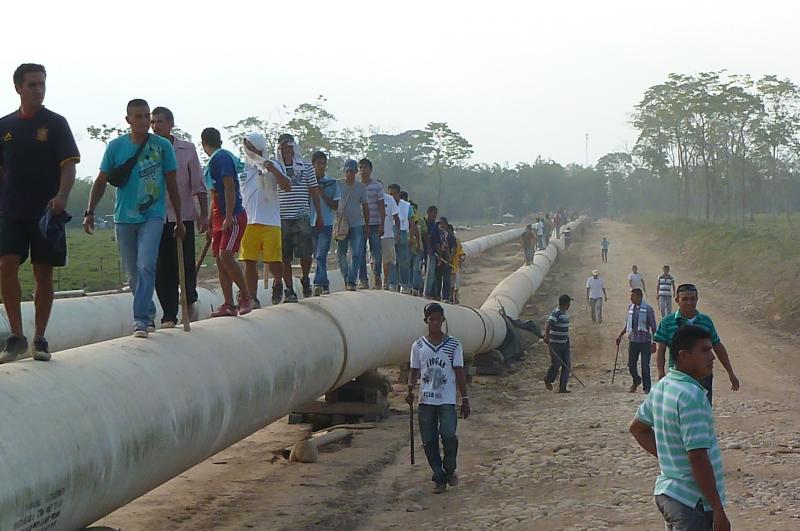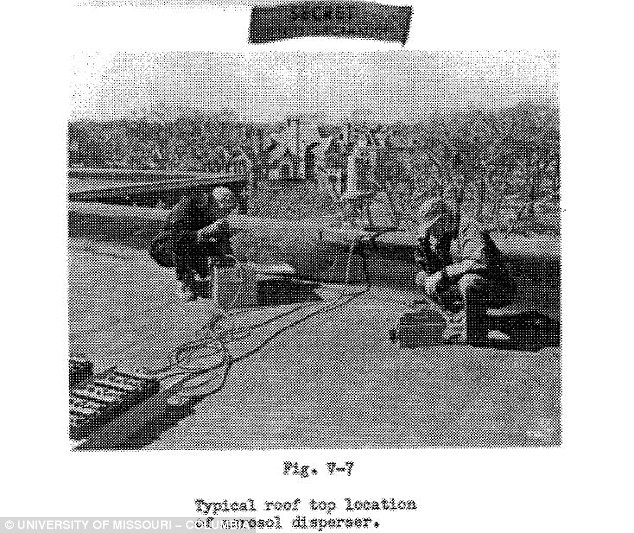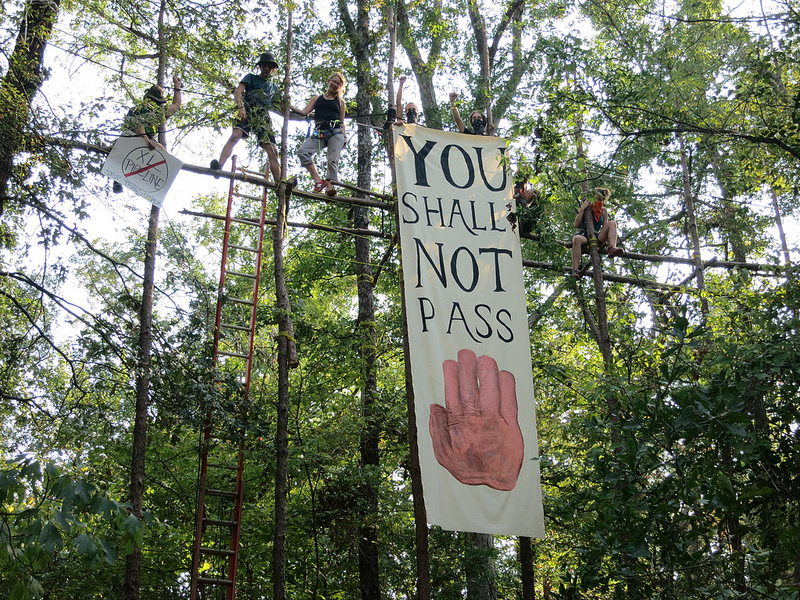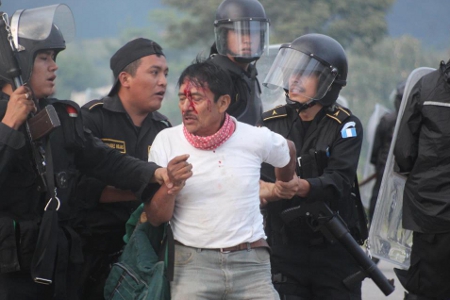
by Deep Green Resistance News Service | Feb 25, 2013 | Indigenous Autonomy, Noncooperation, Protests & Symbolic Acts, Repression at Home
By Colombia Informa; translation by Molly Fohn
After two weeks of peaceful protesting against oil exploitation in Arauca, on February 12 that department’s social organizations began a strike announced a few days earlier as a response to the repeated broken promises by the national government and transnational companies.
The last attempt at dialogue took place on Monday, February 11, between the Commission’s spokespeople (composed of a delegation of indigenous people, peasants, youth, women, workers and community members) and representatives of the Minister of the Interior, as well as oil companies that operate in the region, with the goal of establishing the conditions that would allow the fulfillment of those promises that they’ve been making since May 2012.
The repeated lack of follow-through by the government and businesses, and the delay in the negotiation process caused the fracture in the space for dialogue, followed by the use of state force: approximately 1,200 members of the Mobile Anti-Disturbance Squadron (the ESMAD in Spanish) arrived to violently evict the communities at the protest sites.
The first act occurred on the walkway San Isidro, over the de Tame road toward the Arauca capital, at the gate to the petroleum complex Caricare, which is used by the transnational company OXY, where ESMAD, the Police, and the Army assaulted the mobilized communities by setting fires to the surrounding pastures, discharging their weapons, destroying common buildings (a school), taking away the food supplies to the protestors, and beating and retaining four people.
As a result of the violence, a pregnant indigenous woman who was passing through lost her baby because of the effects of the tear gas, and had to receive emergency attention at a medical center.
The police had kept local and national reporters from contacting CM&, RCN, and other local media that moved to Caricare; the national army set up a checkpoint in the sector of Lipa that prohibited the passage of reporters “for security reasons.” It should be noted that in the Quimbo (Huila) events the police also restricted the presence of the media and acted out a series of violations of basic human rights and International Humanitarian Rights (DIH).
In the face of the this situation, the Human Rights Foundation Joel Sierra posted an Urgent Action which stated its concern for the detention of people, aggression and brutal violence exercised against the peasants and indigenous peoples, the infractions of the International Humanitarian Rights committed by the police to violate and destroy civil installations, and the removal of supplies for feeding those protesting. The Foundation also insisted that the Colombian State respect human rights and the International Humanitarian Rights norms.
In similar form, Urgent Action denounced a series of violations to the protestors’ rights by the police, whose members have dedicated themselves to constantly photograph those that participate in the protests, have retained, interrogated, and reported some of them, and have appeared in civilian clothing and armed in the middle of the night at the edges of the protest sites, among other cases.
In the rest of the protest sites, like the gate to the petroleum complex of Caño Limón in the municipality of Arauca, the town of Caricare in Arauquita, the bicentennial pipeline in Tamacay and el Tigre (Tame) and in Villamaga (Saravena) and the fire substation of Banadías (Saravena), the authorities have sent contingents from the army, the national police, and the ESMAD, because they fear the same will happen in those places that happened in Caricare.
It’s important to note that at this time people and vehicles cannot travel by land to get outside of the department of Arauca by the only two major roads (Casanare and Norte de Santander), and all commerce and activity is completely paralyzed in that region of the country.
From Upside Down World: http://upsidedownworld.org/main/news-briefs-archives-68/4140-colombia-riot-police-attack-communities-protesting-oil-exploitation-in-arauca-
by Deep Green Resistance News Service | Oct 25, 2012 | Toxification
By Leo Hickman / The Guardian
Oil companies operating in the North Sea have been fined for oil spills on just seven occasions since 2000, even though 4,123 separate spills were recorded over the same period, the Department of Energy and Climate Change (Decc) has confirmed.
The disclosure came as Decc said on Thursday that the government had offered a “record-breaking” 167 new licences to oil and gas companies seeking to drill in the North Sea. A further 61 “blocks”, or licences, are under environmental assessment.
Total fines resulting from prosecutions between 2000 and 2011 came to just £74,000 and no single oil company had to pay more than £20,000.
Two companies received fines of £20,000: BP, for causing 28 tonnes of diesel to spill into the sea in 2002 from the Forties Alpha platform, and, a year later, Total E&P, for causing six tonnes of diesel to enter the sea during a transfer between fuel tanks on the Alwyn North platform.
Information about the fines was released by Decc after a freedom of information request and further inquiries by the Guardian.
The smallest fines over this period were those imposed on two companies, Venture North Sea Oil and Knutsen OAS Shipping, of £2,000 each, after 20 tonnes of crude oil was spilt during a tanker transfer on the Kittiwake platform.
In total, 1,226 tonnes of oil were spilt into the North Sea between 2000 and 2011, according to Decc’s archives. Decc said there is no “volume threshold” determining whether a company will be prosecuted over a spill at sea, although a spill of less than five tonnes is unlikely to go to court.
A tonne of crude oil is broadly equivalent to seven barrels, or, more precisely, 1,136 litres.
Decc said its inspectors, all of whom have enforcement powers, judge each case separately to assess the circumstances and the seriousness of the alleged offence.
Slightly different arrangements exist in Scotland from those in England, Wales and Northern Ireland, for pursuing a prosecution.
A Decc spokesman said: “The UK has one of the toughest and most successful oil and gas regimes in the world and we work closely with industry to ensure the highest standards of environmental protection are in place and enforced.
“There are a number of enforcement options available to Decc, with court action reserved for serious offences. On the rare occasions legal proceedings have been deemed necessary, it is for the court to decide the level of fines to hand down.”
Environmental campaigners said it was worrying that Decc viewed itself as operating the global gold standard of offshore regulation, especially as oil companies were now pressing for permission to drill in extreme and vulnerable environments such as the Arctic.
Vicky Wyatt, a Greenpeace campaigner, said: “Ministers and oil companies can spout all the carefully crafted quotes they like to tell us how safe drilling at sea is. But while they’re spouting these words, their rigs are all too often spouting oil into our oceans. The government should hit these companies who pollute the oceans in this way with meaningful fines.
“A few grand is not even a slap on the wrist for companies who pocket millions of pounds every hour.
“It’s both staggering and wrong that some of these companies are now also drilling in the fragile and pristine Arctic, where a similar oil leak would be catastrophic.”
Read more from The Guardian: http://www.guardian.co.uk/environment/2012/oct/25/oil-companies-north-sea-spills

by Deep Green Resistance News Service | Oct 4, 2012 | Toxification, White Supremacy
By David Edwards / The Raw Story
A college professor from St. Louis, Missouri has released research claiming that the U.S. Army conducted secret Cold War tests by spraying toxic radioactive chemicals on cities like St. Louis and Corpus Christi.
St. Louis Community College-Meramec sociology professor Lisa Martino-Taylor told The Associated Press that her research showed that the Army may have sprayed radioactive particles with zinc cadmium sulfide while claiming that it was testing a smoke screen that could prevent Russians from observing St. Louis from the air.
Those tests were concentrated in predominately-black areas of the city, which Army documents called “a densely populated slum district.”
In 1994, the Army confirmed to Congress that St. Louis was chosen because it resembled Russian cities that the U.S. might have to attack with biological weapons.
“The study was secretive for reason,” Martino-Taylor explained to KDSK last month. “They didn’t have volunteers stepping up and saying yeah, I’ll breathe zinc cadmium sulfide with radioactive particles.”
Documents showed that the Army used airplanes to drop the chemicals in Corpus Christi, but sprayers were mounted on station wagons and buildings in St. Louis.
“It was pretty shocking. The level of duplicity and secrecy. Clearly they went to great lengths to deceive people,” Martino-Taylor observed. “This was a violation of all medical ethics, all international codes, and the military’s own policy at that time.”
“There is a lot of evidence that shows people in St. Louis and the city, in particular minority communities, were subjected to military testing that was connected to a larger radiological weapons testing project.”
Doris Spates lived in one of those impoverished St. Louis neighborhoods as a child and has survived cervical cancer. But four of her siblings and her father weren’t as lucky. All five have died of cancer.
“I’m wondering if it got into our system,” Spates told the AP. “When I heard about the testing, I thought, ‘Oh my God. If they did that, there’s no telling what else they’re hiding.’”
Last month, both Missouri Sens. Claire McCaskill (D) and Roy Blunt (R) demanded that Army Secretary John McHugh come clean about the testing. For its part, the Army refused to comment on the matter until it had responded to the senators, the AP reported.
From The Raw Story: http://www.rawstory.com/rs/2012/10/04/u-s-militarys-secret-experiment-sprayed-radiation-on-low-income-housing/

by Deep Green Resistance News Service | Sep 26, 2012 | Obstruction & Occupation
By Tar Sands Blockade
Nine people sitting 80 feet above ground in tree platforms on the path of TransCanada’s Keystone XL construction enter their third day of sustained action to stop the toxic tar sands pipeline. The sitters are undeterred by TransCanada’s role in the torture of their fellow blockaders.
Tuesday, Shannon Bebe and Benjamin Franklin delayed construction for most of the day when they locked arms around construction machinery, intent on protecting East Texas homes. The two were subjected to torture tactics by police only after TransCanada’s senior supervisors huddled with law enforcement to actively encourage the use of extreme pain compliance techniques on the peaceful protesters.
Immediately following TransCanada’s consultation, law enforcement handcuffed the protesters’ free hands to the heavy machinery in stress positions and proceeded to use sustained chokeholds, violent arm-twisting, pepper spray, and repeated tasering to coerce the two to abandon their protest. Extraordinarily, despite their torture, the two endured for over five hours, affirming their courageous stance that taking action now is less of a risk than doing nothing.
Upon the protesters’ arrest, TransCanada supervisors were seen and heard congratulating law enforcement on a job well done.
“TransCanada has frequently claimed its interest in protecting the safety of workers and protestors but now we can see that’s all a lie,” said Ron Seifert a spokesperson with Tar Sands Blockade. “Now that they have actively encouraged the torture of peaceful protestors its clear that this multinational corporation assigns no value to the basic humanity that all Texans and people everywhere deserve.”
With the news that their friends had been tortured with TransCanada’s approval, the eight original tree sitters were bravely joined by another, expanding the tree blockade further as TransCanada’s clear-cutting heavy machinery rapidly approaches. Construction is roughly 300 yards away from the tree blockade. All refuse to come down until TransCanada halts its dangerous pipeline project.
“I climbed this tree three days ago in the path of Keystone XL to demonstrate the dangers of this toxic pipeline and to let TransCanada know that we will continue to non-violently resist their brutal tactics,” said Justin Jacobs, an aerial blockader. “I’m here to defend this land from a multinational corporation who has blatant disregard for the safety of peaceful people, families, and our planet.“
Tar Sands Blockade is a coalition of Texas and Oklahoma landowners and climate justice organizers using peaceful and sustained civil disobedience to stop the construction of the Keystone XL tar sands pipeline.
Concluding hours of hard-fought Keystone XL construction delays, Benjamin Franklin shared, “In light of everything that happened at the direction of TransCanada, I still don’t regret my involvement at all. I encourage everyone to persevere in the face of this type of sheer brutality. To follow one’s moral compass despite extreme challenges is the way we move forward towards a more humane, tar sands-free planet.”
From Tar Sands Blockade: http://tarsandsblockade.org/press/press-releases/

by Deep Green Resistance News Service | Sep 20, 2012 | Lobbying, Mining & Drilling, Repression at Home
By the Committee in Defence of Life and Against Mining in San Rafael Las Flores, CODIDENA, the Parlamento Xinca, CALAS, and the MadreSelva Environmental Collective
Following the events of September 17 and 18, 2012 in Mataquescuintla, Jalapa and San Rafael Las Flores, Santa Rosa, we wish to make the following statement:
TIMELINE OF EVENTS:
1. On the morning of Monday, September 17, employees of the San Rafael Mining Company, accompanied by private security agents with anti-riot equipment, attack dogs, tear-gas cannons and rubber bullet guns, and escorted by the National Civil Police, turned up in Morales, Mataquescuintla, to connect high voltage electrical wires to the San Rafael mining site.
2. Over 500 local community members, men, women and children, came out to demand that the company employees remove their equipment and leave, along with the security guards that were accompanying them. The community had already contested the installation of these electrical wires. They demand a free, prior and informed public consultation on the mining project.
3. The community protest stopped the installation of electrical wires. With the support of the PDH, COPREDEH, the Justice of the Peace and the Municipal Mayors of Nueva Santa Rosa and Casillas, the parish of Mataquescuintla, CALAS and CODIDENA drew up a document stating their desire for a peaceful solution to the dispute. However, just as the document was being signed, provocateurs hired by the mine began throwing rocks at community members and authorities, causing some damage to mining company vehicles and dispersing the group of local residents that had gathered.
4. Angered by this new affront from the San Rafael Mine, residents decided to march from Morales de Mataquescuintla to the main entrance to the mine, which is located in San Rafael. When they got there, in an act of peaceful resistance, the group set up a protest at the entrance to the mine, at the junction of the road from San Rafael Las Flores to El Fusío. At no time did the protesters infringe on the property of the San Rafael mine. They stayed on the public road and on an area of private property, with the owner’s permission. Nonetheless, the national media falsely reported that the protest had invaded the property of the mine.
5. According to eye witnesses, no protesters stepped onto the property of the mine. Given that the mine is heavily guarded, it is therefore impossible that the fire that was started inside the mine was lit without the tolerance and help of the private security guards.
6. At 3 pm, the peaceful protest was attacked without warning by members of the mine’s private security agency, the National Civil Police and the army, using tear gas cannons, firearms and rubber bullet guns. Security agents attacked from inside the mine, with trained attack dogs. The Police cornered the unarmed protestors, and the army surrounded them, crouched and at the ready. The display of repressive force had all the characteristics of military counter-insurgency tactics that we had thought belonged to the past, including the bad intentions, brutality and cowardice that so characterize the tactics of the National Army.
7. This was a cowardly attack by public and private repressive forces against a peaceful civilian group exercising their constitutional right to protest, amongst whom were women with infants, elderly people and small children. Protesters were busy preparing food for all those present, which shows their intention to hold a peaceful protest.
8. From the outset, residents of Santa Rosa have opposed the San Rafael mining operation. The mine was created without prior information or due consultation on the social and environmental impacts that would affect the water supply and the life of the inhabitants of the Santa Rosa valley. This peaceful, legal resistance has included legal documents presented to the Minister of Energy and Mines; peaceful marches from the village to the mine site; protests in front of the Canadian Embassy; visits to the Ministry of Energy and Mines and the Ministry of the Environment; debates with mayoral candidates and meetings with elected mayors; all of which form part of the “Revolución de las Flores” (Revolution of the Flowers) – a peaceful movement. Three public consultations have been carried out in Nueva Santa Rosa, Santa Rosa de Lima and Casillas, and the majority of the people have expressed their opposition to mining.
9. In the meantime, residents of San Rafael have requested that their consultation be recognized as legally binding as per the Municipal Code by mining company lawyers who have boycotted it thus far. Residents also ask for recognition of the consultation by Mayor Leonel Morales Pozuelos and his Municipal Council, whom they hold directly responsible for this conflict and its consequences because of their attitude of servility to the mine and their refusal to respect the demands of the people of San Rafael.
10. As we write this press release, we have just learned that army helicopters are flying over San Rafael and Mataquescuintla, threatening residents, like in the old days of the armed conflict. Once again, the army is carrying out a psychological and military attack on the civilian population to defend the interests of foreign companies.
WE DENOUNCE:
• The criminalization of community leaders who are legitimately defending their lands and their rights against the spurious interests of national and foreign extractive companies that take advantage of the weakness of national laws and corrupt civil servants who have sold out, allowing the destruction of natural resources of our country.
• This kind of provocation is being systematically used by national and foreign companies to further the growth of extractive projects that threaten our natural resources and our lands and are in flagrant violation of the rights of the people, as was demonstrated by what happened in Santa Cruz Barillas and San José del Golfo and San Pedro Ayampuc.
• We warn the government of the country that it should not once again attempt to suspend the constitutional rights of the residents of Santa Rosa, as they tried but failed to do in Santa Cruz Barillas.
We demand that the President of the Republic, the Congress, the Supreme Court, the Public Prosecutor of the Public Ministry, the Army and the National Civil Police:
1. carry out a thorough investigation of the events we denounce here.
2. stop criminalizing the just struggle of the residents of Santa Rosa and Jalapa.
3. punish those responsible for the provocation staged by the mining company and its private security agents.
4. ensure that the Ministry of Energy and Mines deal with the many opposition documents presented by the residents of San Rafael Las Flores regarding the request for an exploitation licence by the San Rafael Mine.
5. cancel the mining exploration licence permanently and refuse to grant under any circumstances an exploitation licence to San Rafael Mining Company.
6. respect the wishes of residents of the municipalities of the Santa Rosa Valley – they have shown their clear opposition to mining activity in the area in a public consultation.
7. refrain from using the state of siege to criminalize and try to prosecute Santa Rosa community leaders who continue the struggle for life, natural resources and land for the benefit of future generations.
8. free the more than thirty community members that have been detained.
WE APPEAL TO:
1. the International community – to pay attention to these violations of human rights in San Rafael Las Flores and Jalapa.
2. the Human Rights Prosecutor – to strictly survey and protect the human rights of our communities, peoples, leaders and social organizations.
3. indigenous, campesino, union, women’s, environmental, youth, etc., social movements – to keep watch on how the situation in Santa Rosa develops and to give their solidarity and support to this just and exemplary struggle.
From Upside Down World: http://upsidedownworld.org/main/guatemala-archives-33/3876-guatemalan-government-and-mining-company-attack-community-members-in-san-rafael-las-flores




